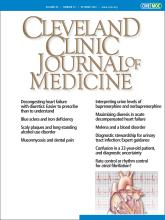Article Figures & Data
Tables
- TABLE 1
Ordering, processing, and reporting urine cultures: Key points of the expert guidance
Stage Appropriate practices Ordering Require documentation of proper (eg, clean-catch) collection
Only test patients with documented signs and symptoms of urinary tract infectionProcessing Use a reflex-culture protocol when possible, so urine without inflammatory markers (ie, white blood cells) is not cultured, as this helps prevent microbial characterization and inappropriate treatment of asymptomatic bacteriuria
Do not routinely work up any isolates when more than 2 types of bacteria are recovered by cultureReporting Optimize laboratory reporting: Include a disclaimer that high colony counts can be present in asymptomatic bacteriuria
“Nudge” prescribers not to treat asymptomatic bacteriuria or mixed growth
Clearly define identified isolates as uropathogen or probable skin contaminant
Use antibiotic cascade reporting, which does not report fluoroquinolones as first-line antibiotics
Based on information in reference 1.
- TABLE 2
Ordering urine cultures: Appropriate and inappropriate signs and symptoms to document
Urinary catheter status Appropriate sign or symptom Inappropriate sign Patient without a urinary catheter Dysuria, suprapubic pain, flank pain, costovertebral angle tenderness, septic shock Altered mental status, change in urine characteristics Patient with a urinary catheter Dysuria, suprapubic pain, flank pain, costovertebral angle tenderness, or septic shock Change in urine characteristics Based on information in reference 1.






